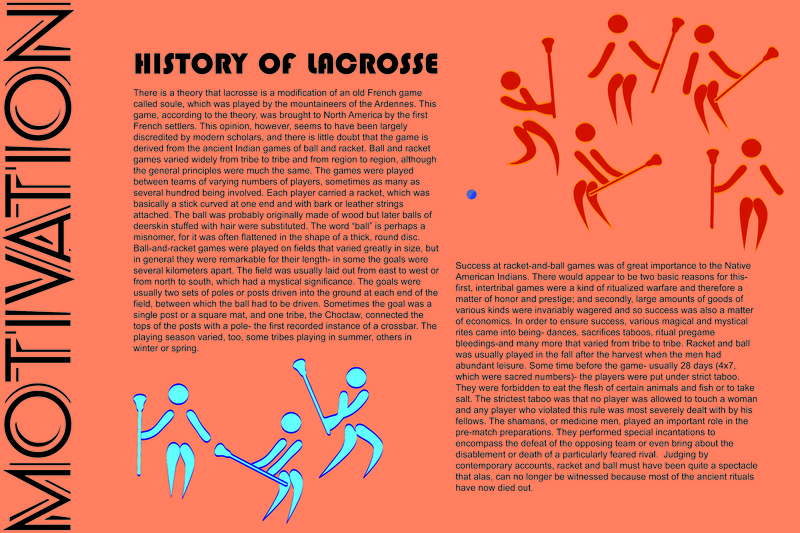History of Lacrosse
HISTORY OF LACROSSE
There is a theory that lacrosse is a modification of an old French game called soule, which was played by the mountaineers of the Ardennes. This game, according to the theory, was brought to North America by the first French settlers. This opinion, however, seems to have been largely discredited by modern scholars, and there is little doubt that the game is derived from the ancient Indian games of ball and racket. Ball and racket games varied widely from tribe to tribe and from region to region, although the general principles were much the same. The games were played between teams of varying numbers of players, sometimes as many as several hundred being involved. Each player carried a racket, which was basically a stick curved at one end and with bark or leather strings attached. The ball was probably originally made of wood but later balls of deerskin stuffed with hair were substituted. The word “ball” is perhaps a misnomer, for it was often flattened in the shape of a thick, round disc. Ball-and-racket games were played on fields that varied greatly in size, but in general they were remarkable for their length- in some the goals were several kilometers apart. The field was usually laid out from east to west or from north to south, which had a mystical significance. The goals were usually two sets of poles or posts driven into the ground at each end of the field, between which the ball had to be driven. Sometimes the goal was a single post or a square mat, and one tribe, the Choctaw, connected the tops of the posts with a pole- the first recorded instance of a crossbar. The playing season varied, too, some tribes playing in summer, others in winter or spring.
Success at racket-and-ball games was of great importance to the Native American Indians. There would appear to be two basic reasons for this, first, intertribal games were a kind of ritualized warfare and therefore a matter of honor and prestige; and secondly, large amounts of goods of various kinds were invariably wagered and so success was also a matter of economics. In order to ensure success, various magical and mystical rites came into being- dances, sacrifices taboos, ritual pregame bleedings-and many more that varied from tribe to tribe. Racket and ball was usually played in the fall after the harvest when the men had abundant leisure. Some time before the game- usually 28 days (4x7, which were sacred numbers)- the players were put under strict taboo. They were forbidden to eat the flesh of certain animals and fish or to take salt. The strictest taboo was that no player was allowed to touch a woman and any player who violated this rule was most severely dealt with by his fellows. The shamans, or medicine men, played an important role in the pre-match preparations. They performed special incantations to encompass the defeat of the opposing team or even bring about the disablement or death of a particularly feared rival. Judging by contemporary accounts, racket and ball must have been quite a spectacle that alas, can no longer be witnessed because most of the ancient rituals have now died out.
